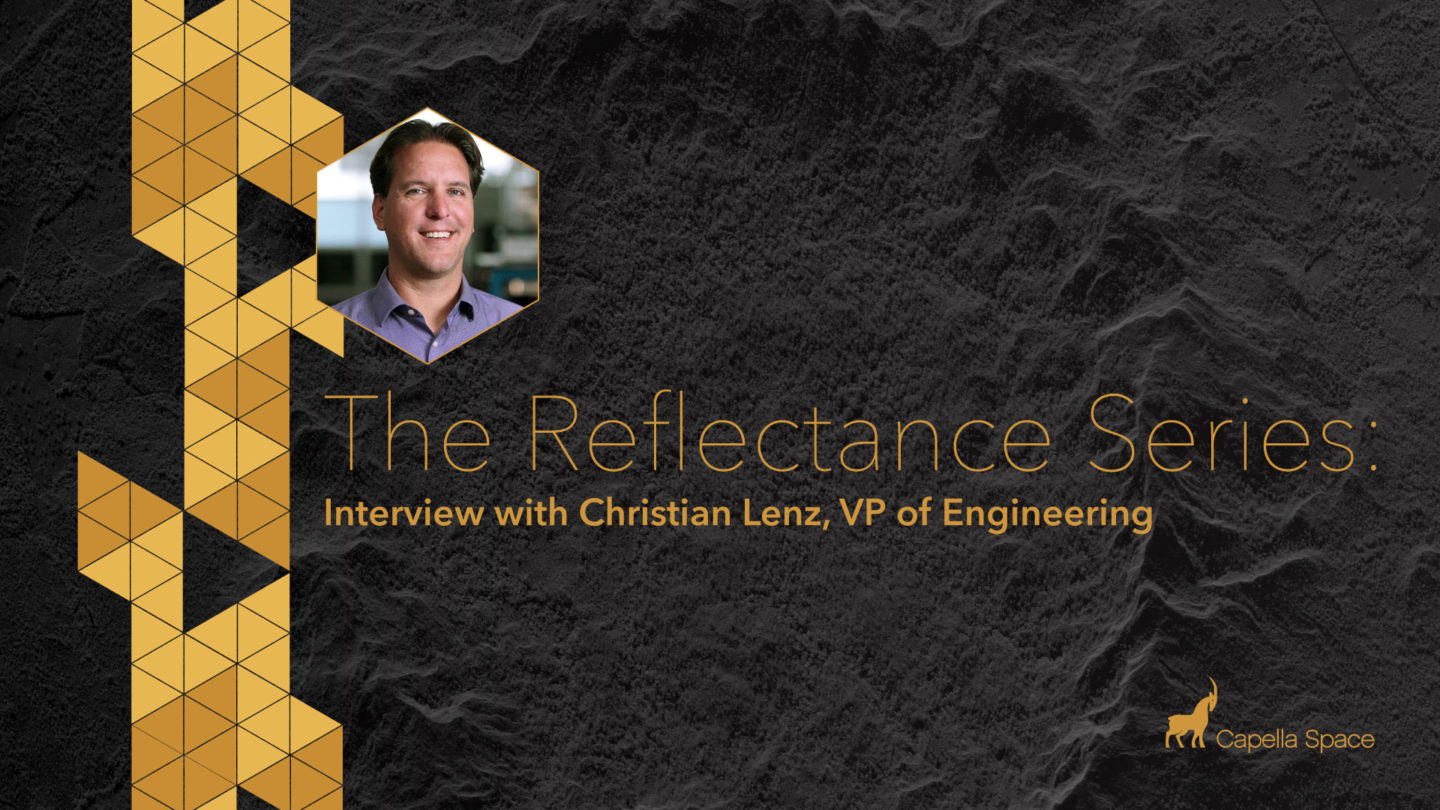
We recently celebrated our five-year anniversary at Capella Space, which gave us the opportunity to reflect on how much we’ve grown since the US Department of Defense challenged us to commercialize SAR technology. As we head into our sixth year, we wanted to showcase some of the great people on our team, across all departments, who have helped us get to where we are today.
This blog post is the first in our new Reflectance Series, which is made up of interviews with the industry’s leading talent in spacecraft engineering, radar systems and satellite operations. These interviews will offer a behind-the-scenes look at some of the people who are pioneering entirely new systems and approaches to help Capella achieve its mission of making timely, high-resolution SAR data available on demand.
I’ll kick off the series with an interview with Christian Lenz, Capella’s VP of engineering.
Can you talk about your career path? What did you do before you worked at Capella, and what made you decide to join our team?
I’ve had an interest in space and engineering for a long time. I was an aerospace engineering major at Arizona State University and got involved early on in a student satellite project there. We launched our first satellite right after I graduated. I joined a startup soon after, where I was able to continue building satellite systems for 17 years. During that time, I was part of a small cohort that was paving the way for small satellites. I recall going to one of the first Small Sat conferences for example and there were only a handful of universities and a few aerospace companies. Now the conference is much larger, including companies from around the globe and all the major prime contractors, indicating the increased interest in small sats and new space activities.
There is a big market need for on-demand SAR data, but SAR is also one of the harder things to do in space. l joined the Capella team because I liked the challenge of making SAR work, and was also very impressed by the team’s high energy and commitment to its mission.
How has SAR evolved over the past 20 years?
Satellite designs have become more diverse, achievable, and capable over the past 20 years. One major factor behind this shift was a generation of engineering students in the 1990s who worked on small-satellite endeavors. These students went on to become the leaders of “Space 2.0,” starting new companies, addressing old problems with space-based solutions, and pushing the envelope of what’s possible and acceptable in the space industry.
In the past, SAR satellites were the domain of only a few, very well-funded government agencies. These systems cost hundreds of millions of dollars to design, launch, and operate, took 10+ years to develop, and were generally very large. As a result, SAR was relegated to very exclusive users.
It’s a bit like the situation we saw with early computing. Large mainframes were the domain of governments and rich banks because they were expensive and complex to operate. It took the arrival of the personal computer to upend the world of computing forever. The philosophy behind Space 2.0 mirrors that development in that people are now building highly capable systems that are easier to own and operate. When deployed in greater numbers, these systems enable a whole new generation of applications, open up the data for new users, and accelerate technological progress around SAR and the wider space industry.
In what ways is Capella’s SAR technology unique from other satellite systems?
At Capella, we have the only SAR system currently in the commercial space that can provide true 50 cm ground resolution coupled with very high image quality, the highest on the market. In SAR, both matter. We achieve this by having a very advanced electronics package coupled with an antenna design that stores in a small package yet deploys to a very large system on orbit.
We also balance priorities differently than what may have been done historically in the industry. Previously, satellite systems were built to last 15 years and were often overengineered. Satellite missions were once-in-a-decade deployments. As a result, innovation was slow, costs were high, and frankly job satisfaction was low.
Our satellites follow a different approach. They are designed quickly and are intended to be improved upon every few years. And because of all that, our work has been able to become more innovative, responsive, inclusive, and fun.
What are some challenges the SAR industry faces today?
One big issue facing us all is the use of radio spectrum. In a radar system, resolution is a function of bandwidth — and we all want better resolution which means we need to use more bandwidth. This means we need to contend with other users, such as ground-based radars on ships, radio telescopes, and communication systems. On top of that, we generate a lot of data that needs to be beamed back to Earth. To get high speed downlinks, we need more bandwidth again. In the long run, the industry needs to go to higher frequencies and optical systems to enable much higher data rates.
Another challenge we face in the US is the resolution limit imposed by the US government. This limit was put in place for good reason, but it’s more restrictive than legislation in other parts of the world, like the EU. To maintain a leading edge in the SAR industry, we’d like to see US regulations stay at least on par with global standards. There is an opportunity here for the US to lead.
What applications of Capella’s technology are you the most excited for?
All-weather visibility coupled with rapid revisit is very exciting. Nobody can truly do this today. When you couple this with the right analytics, you have a very powerful, automated observation system. The applications that excite me the most are related to detecting events as they happen in near real time. This could be forest fires, flooding, deforestation, or other man-made events. For example, when the massive container ship, the Ever Given, unexpectedly blocked the Suez Canal, our satellites were the first to capture and deliver a very high-resolution SAR image of it. The Earth is a really big place, yet events around the globe affect us all — having a system to detect and observe in near real time is very exciting.
Next up: I hope you enjoyed this interview with Christian Lenz. In our next Reflectance interview, we’ll speak with Dr. Duncan Eddy, who leads our satellite operations in the coming weeks, so keep an eye out on our blog.

